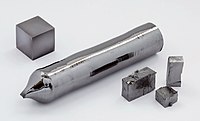
Photo from wikipedia
The application of nontoxic 2D transition‐metal carbides (MXenes) has recently gained ground in bioelectronics. In group‐4 transition metals, tantalum possesses enhanced biological and physical properties compared to other MXene counterparts.… Click to show full abstract
The application of nontoxic 2D transition‐metal carbides (MXenes) has recently gained ground in bioelectronics. In group‐4 transition metals, tantalum possesses enhanced biological and physical properties compared to other MXene counterparts. However, the application of tantalum carbide for bioelectrodes has not yet been explored. Here, fluorine‐free exfoliation and functionalization of tantalum carbide MAX‐phase to synthesize a novel Ta4C3Tx MXene‐tantalum oxide (TTO) hybrid structure through an innovative, facile, and inexpensive protocol is demonstrated. Additionally, the application of TTO composite as an efficient biocompatible material for supercapacitor electrodes is reported. The TTO electrode displays long‐term stability over 10 000 cycles with capacitance retention of over 90% and volumetric capacitance of 447 F cm−3 (194 F g−1) at 1 mV s−1. Furthermore, TTO shows excellent biocompatibility with human‐induced pluripotent stem cells‐derived cardiomyocytes, neural progenitor cells, fibroblasts, and mesenchymal stem cells. More importantly, the electrochemical data show that TTO outperforms most of the previously reported biomaterials‐based supercapacitors in terms of gravimetric/volumetric energy and power densities. Therefore, TTO hybrid structure may open a gateway as a bioelectrode material with high energy‐storage performance for size‐sensitive applications.
Journal Title: Advanced Functional Materials
Year Published: 2021
Link to full text (if available)
Share on Social Media: Sign Up to like & get
recommendations!